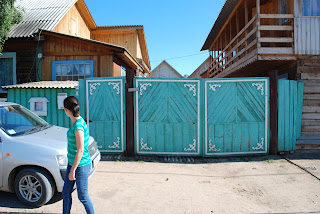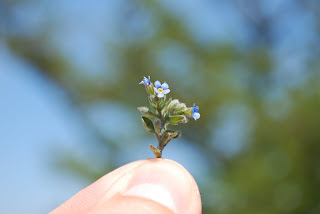 Baikal is the world's deepest lake, and holds 20% of the planet's fresh water. There are all sorts of statistics that you hear when you read up on Baikal, but the most surprising to me was this: there is enough water in Lake Baikal alone to support all the people on earth for the next 50 years. It's also home to the world's only species of fresh-water seal. Kind of surprising to think that most of us never learned about this place in school.
Baikal is the world's deepest lake, and holds 20% of the planet's fresh water. There are all sorts of statistics that you hear when you read up on Baikal, but the most surprising to me was this: there is enough water in Lake Baikal alone to support all the people on earth for the next 50 years. It's also home to the world's only species of fresh-water seal. Kind of surprising to think that most of us never learned about this place in school. It took us about 6.5 hours to get from the city of Irkutsk to our final destination: a homestay in the tiny town of Khuzhir on Olkhon Island (an island in the middle of the lake).
It took us about 6.5 hours to get from the city of Irkutsk to our final destination: a homestay in the tiny town of Khuzhir on Olkhon Island (an island in the middle of the lake).
We had to take a ferry to get there:
Our "homestay" actually turned out to be something more akin to a Bed & Breakfast. There was a small main house (where the owner and her family lived), a separate building with about 4 rooms (that's where we stayed), and a kitchen / dining room area.


It was a very comfortable place to stay, except for one convenience that was very conspicuously absent: indoor plumbing. Showers were creatively handled through a home-made gravity-fed camp-style shower (with water heated by the sunshine). Other bathroom issues, however, were solved in a more traditional way: outhouses. After only two nights in Siberia, Emily has decided that flush toilets are the most important invention of human history. Here's a look at the long walk from our room to the outhouse (imagine doing this during the legendary Siberian winters):
The town of Khuzhir (like pretty much everywhere on Olkhon Island) is right on the shore of the lake. During our stay, we took several long walks through the town and down to the small beach nearby. Emily remarked that walking through the town was like stepping back in time to the days of the Wild West.
 All of the houses in the town were made of wood, and although they were mostly unpainted, their owners found a very unique way of expressing their creativity: their windows. Some were cut into pretty patterns (above) and some were painted with bright colors.
All of the houses in the town were made of wood, and although they were mostly unpainted, their owners found a very unique way of expressing their creativity: their windows. Some were cut into pretty patterns (above) and some were painted with bright colors.
 The charm of Siberian villages seems to be best expressed in their windows...or maybe in their advertisements (I'm guessing the circus was coming to town?)
The charm of Siberian villages seems to be best expressed in their windows...or maybe in their advertisements (I'm guessing the circus was coming to town?)
On our second day on the island, we took a Four-Wheel-Drive tour of the island. (below is the sturdy Russian van that we rode in. The driver was very proud of his van and proclaimed that he would not part with it for less than 10,000 Euros).

Olkhon Island is about 70km long, but it takes quite awhile to traverse (owing to the primitive state of the roads). We spent all day driving from one lookout point to another, and got some great pictures along the way:


We stopped a number of times throughout the day to take little hikes along the clifftops:


You might have noticed the colorful rags tied to trees in some of these photos. Those rags are indicative of the spiritual importance assigned to those trees by the local "Buryat" people of Lake Baikal. They follow a traditional Shamanistic religion, which assigns spiritual powers to major landmarks (trees, cliffs, etc). Here's the tree at the "Shaman Rocks" in our town of Khuzhir:
 We found Olkhon Island to be quite varied in its terrain. There were patches of pine forest, wide open grassy areas (that had supported vast herds of sheep during Soviet times), and beautiful cliff-top lookouts from which we saw breathtaking views of the lake. In one of the grassy areas, we found some very unusual (and tiny) wildflowers:
We found Olkhon Island to be quite varied in its terrain. There were patches of pine forest, wide open grassy areas (that had supported vast herds of sheep during Soviet times), and beautiful cliff-top lookouts from which we saw breathtaking views of the lake. In one of the grassy areas, we found some very unusual (and tiny) wildflowers: Around noon, we stopped at a beautiful little meadow for lunch. Our driver hopped out of the van and told us to come back in an hour to eat. When we got back to the van, he had laid out a full lunch: salad, crusty bread with butter, and hot fish soup. It was surprisingly good:
Around noon, we stopped at a beautiful little meadow for lunch. Our driver hopped out of the van and told us to come back in an hour to eat. When we got back to the van, he had laid out a full lunch: salad, crusty bread with butter, and hot fish soup. It was surprisingly good:


 When we returned from the day's driving tour, we had another surprise waiting. "Olga" (the owner of our "B&B") had prepared a "Banya" for us. For those of you unfamiliar with Siberian traditions, a Banya is a Siberian version of a sauna. Here's Emily's explanation of the process:
When we returned from the day's driving tour, we had another surprise waiting. "Olga" (the owner of our "B&B") had prepared a "Banya" for us. For those of you unfamiliar with Siberian traditions, a Banya is a Siberian version of a sauna. Here's Emily's explanation of the process:We only stayed in the Banya for about 20 minutes. It's an exhausting process of ducking in and out of a sweltering-hot room and repeatedly dousing yourself with icy water from the well. The local family looked disapprovingly at us when we emerged so quickly from the Banya (we noticed that they tended to stay in there for about an hour every night)
We then took another walk through the town, back down to the shore of the lake.
 The local Shamanistic traditions assign varying levels of good luck to different places around the island. However, the highest level of luck is reserved for the lake itself. We were told that if you immerse yourself completely in the icy waters of Lake Baikal (it's only a few degrees above freezing, even in the summer), you can add 7 or more years to your life. I (Brad) decided to give it a go:
The local Shamanistic traditions assign varying levels of good luck to different places around the island. However, the highest level of luck is reserved for the lake itself. We were told that if you immerse yourself completely in the icy waters of Lake Baikal (it's only a few degrees above freezing, even in the summer), you can add 7 or more years to your life. I (Brad) decided to give it a go:I felt more like 7 years had been taken off my life, but it was certainly an invigorating experience.

The next morning, we made the 6 hour drive back to Irkutsk (above is a photo of the road to Irkutsk). Early the next morning we were back on the train (a Chinese train this time) and headed for our next stop: Mongolia.
 It was much more basic than the modern Russian train we'd taken from Moscow to Irkutsk. As we were now turning south (off the "official" Trans-Siberian line), we were no longer using electric trains. Here's a video of the engine-changing process just before we crossed into Mongolia:
It was much more basic than the modern Russian train we'd taken from Moscow to Irkutsk. As we were now turning south (off the "official" Trans-Siberian line), we were no longer using electric trains. Here's a video of the engine-changing process just before we crossed into Mongolia:It was a very sweaty 24 hours. We had a lovely little cabin (with a private bathroom!), but it was not air-conditioned (as the engine apparently couldn't provide enough electricity to run the A/C).

 The temperatures hovered around 38 Celsius (that's about 100 farenheit), and we spent most of the day either sweating in our cabin or sitting at border posts waiting (and sweating) for customs officials to inspect our train with a fine tooth comb.
The temperatures hovered around 38 Celsius (that's about 100 farenheit), and we spent most of the day either sweating in our cabin or sitting at border posts waiting (and sweating) for customs officials to inspect our train with a fine tooth comb.The next morning, we awoke to see Mongolian "Gers" (yurts) in the distance. It was a much different experience than Siberia and we'll write all about it in a week or so. In the mean time, feel free to comment. If you need a topic for comment, consider "translating" that advertisement we saw in the village of Khuzhir (what do you think that cross-dressing chimpanzee was trying to sell?)
thanks for posting more on your summer trip!! I was wondering when more was coming.... Have you guys started writing your travel memoirs??
ReplyDeleteI (brian) am so bummed I didn't get to go out to this part of Russia. Really pretty. And uh... the russian word for circus is Tsirk which is exactly what that sign was for.
ReplyDeleteThanks for your translation expertise, Brian! It was kind of bothering me not knowing what that sign was for (although the truth turned out to be less exciting than the wild stories my imagination churned out). We're looking forward to (hopefully) seeing you two this Christmas!
ReplyDelete